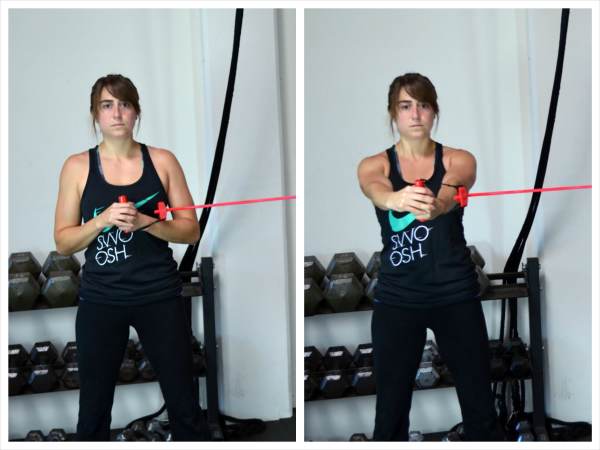ROLL OUT
Wrists/Forearms
Chest
Shoulders/Traps/Upper Back
Lats
Thoracic Extension
(Below in the Exercise Descriptions are some basic moves for the areas.)
STRETCH
10 reps Wrist Extension
10 reps Wrist Flexion
10 reps Kneeling Thoracic Extension and Lat Stretch
10 reps each way Quadruped Shoulder Circles
10 reps per side Lying Chest Stretch and Scorpion
10 reps Camel
ACTIVATION
Complete 2-3 rounds of the circuit below.
CIRCUIT:
10-15 per side Back of Hand Band Rows
30 second Downward Dog Hold
15-20 reps Scapular Push Ups
WORKOUT
Complete 3-5 rounds of the circuit below. Rest as needed. This isn’t a fast workout. Instead you want to focus on activating your back and core to reverse the effects of sitting all day.
CIRCUIT:
8-12 reps Inverted Rows
8-12 reps per side Plank with Reach Out and Back
10-15 reps Back Flyes
10-15 reps Stability Press
NOTES:
Really focus on your posture and standing up nice and tall. Also focus on engaging your back and drawing your shoulders down and back. Do not shrug. Focus on your back pulling, your abs bracing and your entire core working.
Ready for 10 minute workouts to improve your posture AND help you alleviate aches and pains? Check out my RStoration Method!
EXERCISE DESCRIPTIONS:
Wrists/Forearms – To roll out your forearm, place a small ball or roller up on your desk, table or even a box. Place your forearm over the ball with it right below your elbow. Press down on your forearm with your other hand to press it into the ball. Make small circles on the ball, holding on any tight spots. If you find a tight spot, you can also tense and relax your forearm by either making a fist or by pointing your fingers down toward the ground. By flexing and relaxing the muscles, you help the ball dig in and release the tight spot. Once you’ve worked on one spot, move the ball down your forearm. You can use it to roll out both sides of your forearm. Make sure to get the outside and inside of your forearm as there can be trigger points in both spots causing your wrist and elbow pain. Don’t waste time on any areas that aren’t tight or sore. Seek out and spend time on any areas of pain. Apply as much pressure as you can handle and use as small and hard a ball or roller as you can.
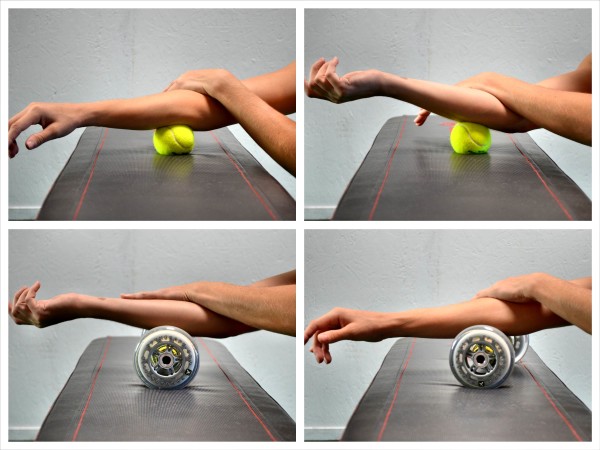
Chest – To roll out your chest, a blue foam posture ball is a great tool although you can use a small ball against a wall or up on some books. Place the ball on the ground and lie face down on top of it with the ball right in your chest beside your shoulder joint. Then with the ball right to the inside of your shoulder, move your hand overhead and then back down toward your legs. Move your arms slowly up and down to change exactly how the ball digs into your chest muscles. Hold and relax on any tight spots.
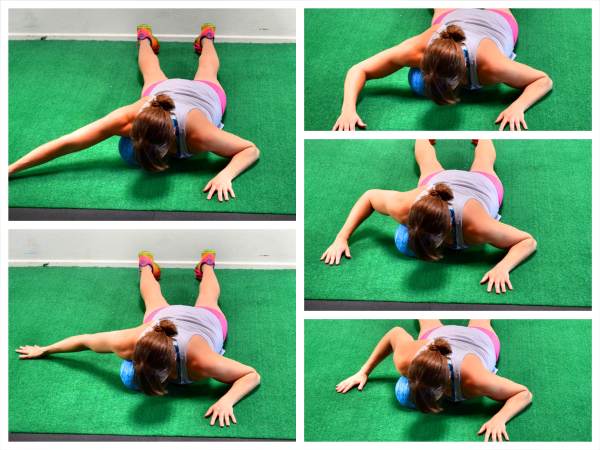
Shoulders/Traps/Upper Back – To roll out your upper back with a ball, stand with your back to a wall and place the ball to the side of the base of your neck. Press the ball into the wall and roll it down along your shoulder blade. Hold on any tight spots. You may even want to pull your arm across your chest as you dig out under the shoulder blade. You can also use the ball against the wall to dig out right at the top of your armpit. If you want to apply more pressure with the ball, you can use a harder ball or use the ball against the ground instead of the wall.

Lats – To roll out your lats, place a roller under one armpit when you are lying on your side on the ground with your arm stretched out overhead. Rock forward and backward on the roller and then move it lower down the side of your back. Hold on any tight spots as you go and make sure to rock forward and backward as you make your way down your side. Work all the way from your armpit to the end of your rib cage.
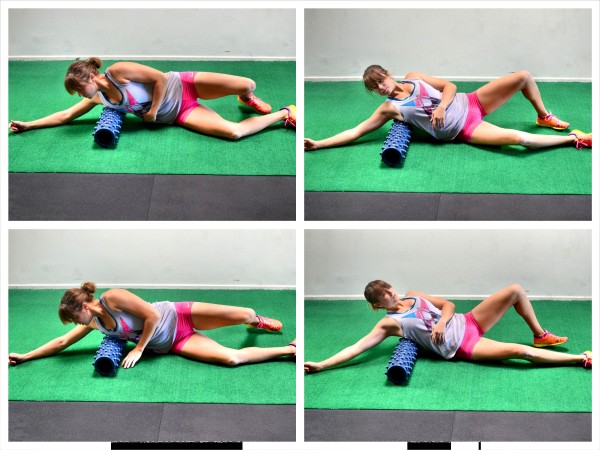
Thoracic Extension – To work on your Thoracic Extension using a roller, place the roller on the ground and lie back over the roller with your butt on the ground, your knees bent and your feet on the ground. Make sure you start with the roller in your mid-back. You do not want to do this move with the roller in your low back or you could hyperextend your low back. Cross your hands over your chest and, keeping your butt on the ground, extend your back over the roller. As you relax and extend back over the roller, reach your hands overhead and relax your head and neck. Try to touch the backs of your hands to the ground behind you without lifting your butt up off the ground or only extending from your low back. Focus on extending your mid and upper back over the roller. Sit back up and cross your hands back over your chest. You can then repeat, relaxing and extending over the roller as you reach your arms back overhead. Perform the extension a few times, especially if the area feels tight, and then move the roller higher up on your back and repeat. Hold for a second or two as you extend so that you can breathe and relax more over the roller. Work all the way up your mid to upper back. Do not do this move on your lower back.
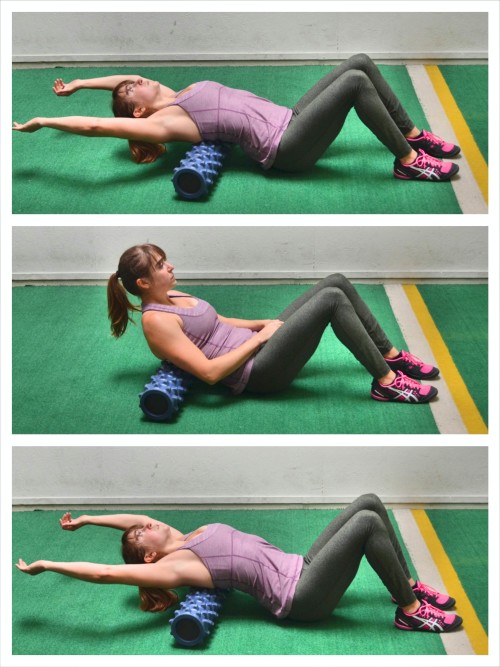
Wrist Extension – To do the Wrist Extension Stretch, kneel on the ground and place your hands down on the ground in front of you, palms down. Turn your fingertips out and back toward your knees. Then rock back, sitting on your heels, keeping the heels of your palms down on the ground as you sit back. Come back out of the stretch then sit back again, stretching down the inside of your forearms.
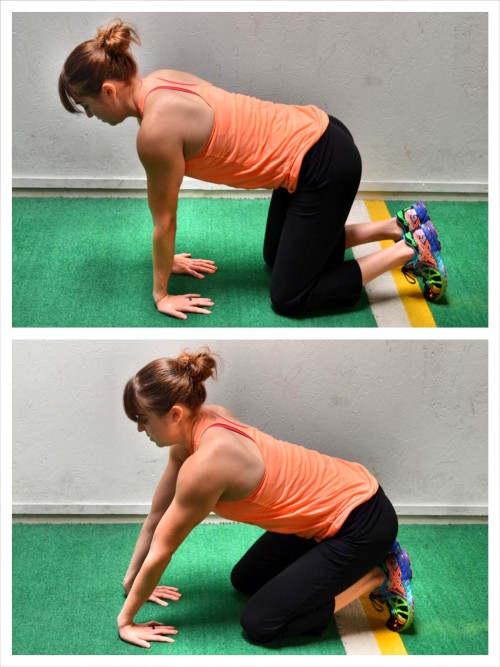
Wrist Flexion – To do the Kneeling Wrist Flexion Stretch, start kneeling on the ground. Place your hands down on the ground in front of you with the backs of your hands on the ground and your fingertips pointing in toward each other. Rock side to side slowly, holding slightly to each side so that you feel a stretch down the outside of your forearms.
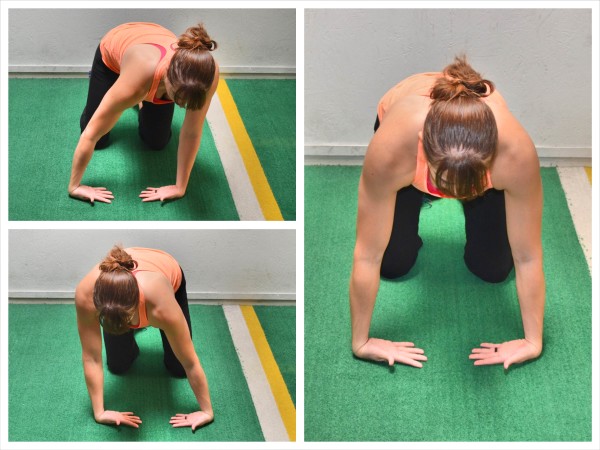
Kneeling Thoracic Extension and Lat Stretch – To do the Kneeling Thoracic Extension and Lat Stretch, place your elbows up on a bench about shoulder-width apart and kneel on the ground in front of the bench. Make sure you are back far enough that you have room to lean forward and over and drop your head between your elbows. Then with your elbows on the bench, relax your chest and head over, sitting your butt back just slightly. Press your chest toward the ground and feel a nice stretch down your triceps and lats as well as through your thoracic spine. Try to extend your back as much as possible as you press your chest toward the ground. You can either hold here and breathe to stretch deeper or you can come out of the stretch and then relax back into it and try to get further with each rep.
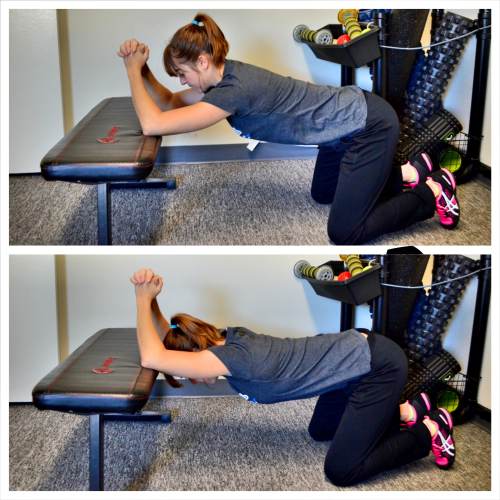
Quadruped Shoulder Circles – To do Quadruped Shoulder Circles, set up on your hands and knees with your hands under your shoulders and your knees under your hips. Without bending your elbows, begin to circle your shoulders forward. Bring them up toward your ears then circle them back toward your hips and back down and around. Try to make a big circle while keeping your arms straight. Circle forward a few times then reverse the circles. It make almost feel like you are circling your back around your shoulders, especially in reverse. Take it slow and focus on the circles. Don’t simply shrug and unshrug your shoulders. Circle backward a few times, still not bending your elbows as you circle. Also, do not sit back on your heels as you move.

Lying Chest Stretch and Scorpion – To do the Lying Chest Stretch with Scorpion, lie on your belly with your arms out straight at shoulder height. Bend the elbow of one arm to 90 degrees so that your upper arm is still in line with your shoulder. Then lift the opposite leg up from the bent arm and bend your knee to kick your foot over and behind you as you press your chest open with your straight arm. Kick your leg back over your body, trying to touch your toe back behind you and feel a stretch through your chest and low back. You should feel a nice stretch down the front of the shoulder of the bent arm. Make sure as you reach the leg back over that you relax your head down onto the ground. Hold for a second or two then bend the other arm and kick the other leg back over. Alternate sides, holding for a second or two each way.

Camel – To do the Camel, kneel on the ground with your knees about hip-width apart and your feet flexed. If you point your toes instead, this will make the move harder and require more flexibility (bottom two photos). Also, flexing your feet will stretch the bottom of your feet more while pointing your toes will get your shins more. With either your feet flexed or pointed, sit back on your heels and place your hands on your heels. Then arch your hips up and away, as you press your chest out and lift your glutes up off your heels. Keep your hands on your heels as you arch away and squeeze your glutes to fully extend your hips. Do not hyperextend your low back. Engage your glutes to stretch out your hips. Relax your head back and arch as much as you can, getting a nice stretch down your chest, core, hips and quads. Do not let your shoulders shrug and really focus on opening your chest up. Hold for 1-2 seconds and relax back down. Repeat, arching back up. You can also make this a static stretch by simply holding the pose for 15-20 seconds. If you are less flexible and can’t place your hands on your heels, you can do this stretch with a couch, chair or table behind you. Kneel down with the coach or table behind you. Place your hands back behind you on the couch or table. If you are at your desk, you can use your desk or chair. Keeping your arms straight behind you, press your chest out and arch away from the piece behind. Relax your head back and really squeeze your glutes to arch away.
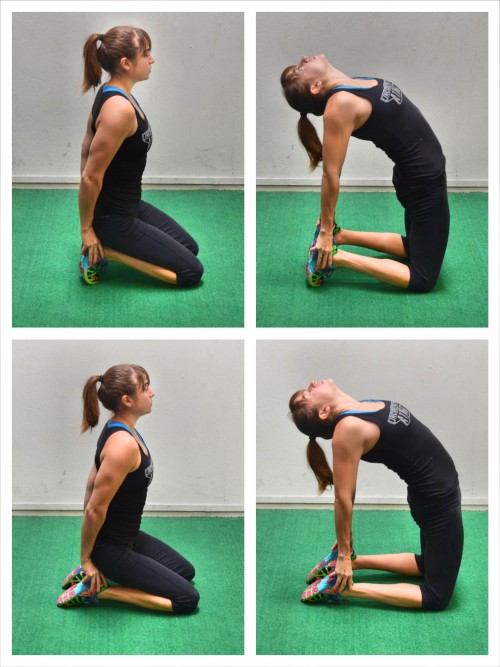
Back of Hand Band Rows – To do the Back of Hand Band Row, anchor a resistance band in front of you and either loop it or make sure it has a handle you can put your hand through. Place the band or handle around the back of your hand and point your fingers up toward the ceiling. Step away from the anchor point so that there is tension in the band with your arm extended in front of you. Stand up nice and tall and press your chest out as you face the mini band. Your feet should be about hip-width apart. Make sure you aren’t shrugging your shoulders as you hold your arm out in front of you with the band around your hand. Then drive the elbow down and back as you row the back of your hand and the band into right below your chest. Row low so that you don’t shrug your shoulder. Also, don’t rotate as you row. Feel your back pull the band back. Don’t just use your arms. Also, make sure that your upper traps don’t try to take over. Really press the chest out and drive the elbow down and back. Straighten the arm back out and repeat. Focus on feeling your back pull the band and not just your arm. By focusing on what muscles should be working, you will improve your mind-body connection. Also, make sure to keep your fingertips pointing up toward the ceiling to engage the extensors in your forearm.

Downward Dog Hold – To do the Downward Dog, start in the high plank position with your hands under your shoulders and your feet about hip-width apart. Without walking your hands back toward your feet, push your butt up toward the ceiling as you press your chest back toward your legs and drive your heels down toward the ground. Keep your arms straight as you press your chest back and try to get your biceps by your ears. Make sure to press through your entire hand and not simply rock toward the outside of your palms. Feel your fingers gripping the ground. As you hold, focus on getting your back flat and a nice straight line from the heels of your hands up to your tailbone. You want your arms to be in line with your torso (aka your biceps by the ears). As you press through your hands to get your back flat, focus on also driving your heels down as you lengthen through your hamstrings. Really push your butt back and up as you hold the downward dog position and try to drive your heels down toward the ground. Breathe and try to relax deeper into the stretch. While you may need to adjust your exact hand positioning, do not walk your hands in closer to your feet just to get your heels down. You want to make sure you are really focused on driving your chest back and extending your spine to improve your thoracic extension and stack your shoulders.
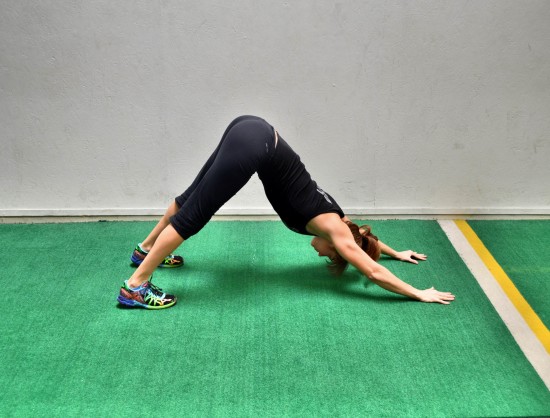
Scapular Push Ups – To do the Scapular Push Up, set up in a high plank position with your hands under your shoulders and your feet together. Your body should be in a nice straight line from head to your heels. Without bending your elbows or dropping your hips, pinch your shoulder blades together and press your chest out. Do not tuck your chin or jut your head forward. Also do not let your core wiggle or your elbows bend to try to increase your range of motion. You are not doing a push up. This is a very small range of motion where you are simply focused on pinching your shoulder blades together. Just pinch your shoulder blades together and then relax or even round your back up out of it (rounding your back at the top is another variation but can be very useful for correcting certain push up problems). Keep your core tight as you pinch your shoulder blades together. As you get stronger and build the mind-body connection you will find your range of motion increases. If you struggle to pinch your shoulder blades together without wiggling your core or bending your elbows, go down to your knees as if doing a push up from your knees. If you still struggle, bring your knees under your hips. Do not get caught up on doing this from your toes. Just focus on pinching the shoulder blades together.
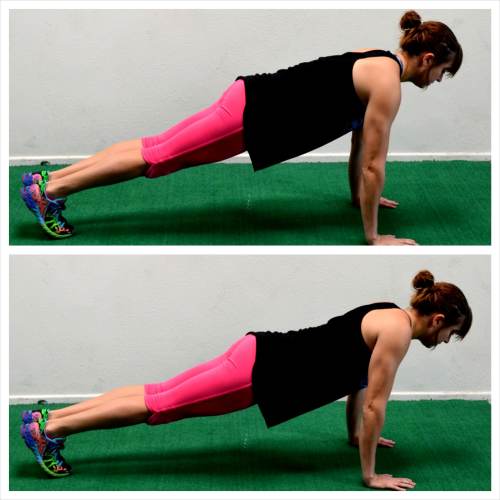
Inverted Rows – To do the Basic Inverted Row, you can either use a Suspension Trainer or a Bar. Using a Suspension Trainer, hold a handle in each hand with your palms facing in. Walk your feet forward so that your body is at an incline. The closer to parallel to the ground you get, the harder the move will be. Hang from the straps with your body in a nice straight line and your chest pressed out. Engage your core and glutes and keep your legs straight. You want a nice straight line from your head to your heels. Do not let your low back arch or your hips sag toward the ground. Then drive your elbows down and back to row your chest up to the handles. Keep your body in a nice straight line as you row up and do not bounce off the bottom. Keep your wrists straight as you row up. Also, do not shrug your shoulders. Then lower back down. Do not lose tension at the bottom. Make sure to keep the chest pressed out and your body in a nice straight line. Do not swing to row back up. Make sure to feel your back and arms working to row and not just your arms. Focus on feeling your back pull.
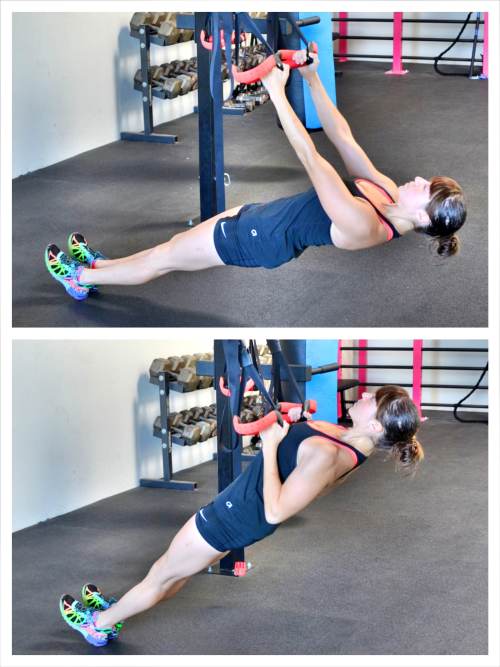
Plank with Reach Out and Back – To do the Plank with Reach Out and Back, set up in a Front Plank from your hands and toes with your hands under your shoulders and your feet about hip-width to shoulder-width apart. For this move, you will want your feet wider to create a more stable base. Beginners can do this move from their knees. Then from the Plank position, reach one hand back and across toward the opposite ankle, pushing your butt back and up toward the ceiling as you reach. Then reach back forward and out toward the wall in front of you, dropping your hips back into a nice plank position. Do not drop your hips too low and feel your low back engage. Keep your core tight to protect your low back as you come back into that nice plank position. Reach back and across with the same hand until all reps are complete on that side.
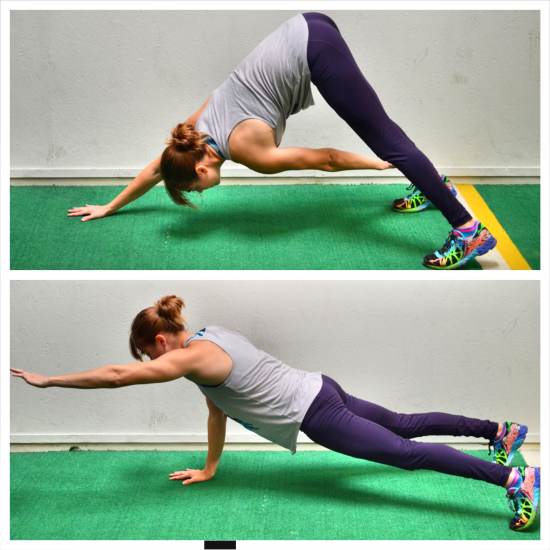
Back Flyes – To do Back Flyes using dumbbells, hold a light dumbbell in each hand. Start light so that you can focus on your upper back and the backs of your shoulder’s working without engaging your upper traps, neck or lower back. Hinge over at the hips holding the weights with your arms hanging straight down toward the ground. Keep your back flat and slightly bend your knees. Make sure to drop your chest to about parallel to the ground. If you start to stand back up, you could start to overuse your upper traps instead of using your upper back. You do not want to turn this into an upright row. Then, bracing your abs, fly your arms out to the side. Keep your elbows soft as you lift your arms out to the sides and back toward the ceiling at about, or just below, shoulder height. Pinch your shoulder blades together as you fly your arms open and really feel your upper back and the backs of your shoulders working. Keep your neck relaxed as you fly. Lower back down and repeat the fly. Try not to swing, but really focus on using your back to lift. Also, make sure to keep your elbows soft as you fly your arms up and out. If you feel your neck and upper traps engaging, you can place your head against the wall or on top of a bench. Also, make sure your low back doesn’t engaged as you keep your back flat. You may need to brace your abs more or bend your knees slightly, especially if your hamstrings are tight.
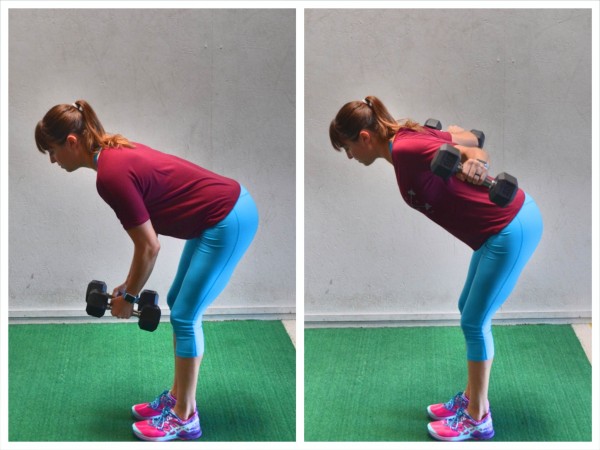
Stability Press – To do the Stability Press, you can use a resistance band or cable. If you are using a band, anchor the band and then hold one handle in both hands. Turn to the side so you are sideways to the anchor point and step away from the anchor point so that there is tension in the band. You want to make sure there is tension or the move won’t be challenging. Stand with your feet no more than shoulder-width apart. The closer your feet are together, the harder the move will be. Choose a stance though that challenges you while allowing you to maintain good form and not lean away. As you become stronger, bring your feet closer together and then even try a heavier band or walk further from the anchor point. Bring your hands into the center of your chest and squeeze your glutes while you brace your abs. Standing up nice and tall with your chest pressed out, slowly push the band straight out from the center of your chest until your arms are straight out. It should be a struggle to press the arms straight out because the band is trying to rotate you back toward the anchor point. Your core should have to work to stabilize and press straight out from your chest. Do not let your arms rotate open and go back toward the anchor. You want to press straight out from the center of your chest without shrugging your shoulders. Maintain a nice tall posture with your shoulder blades drawn down and back and your core engaged. Make sure you also don’t lean away. Then slowly bring your arms back in and repeat. Move slowly to really have to fight the band. If you move too quickly, you won’t get as much out of the move and you’ll probably get sloppy and let yourself rotate toward the anchor point or even shift open and push away. Also, if you allow your stance to rotate open or if you lean away, it will make the movement easier and won’t force that inside side (the side closest to the anchor point) to really work to stabilize. Complete all reps on one side before turning and facing the other way to work the other side. Really consciously engage your glutes before starting to press.
